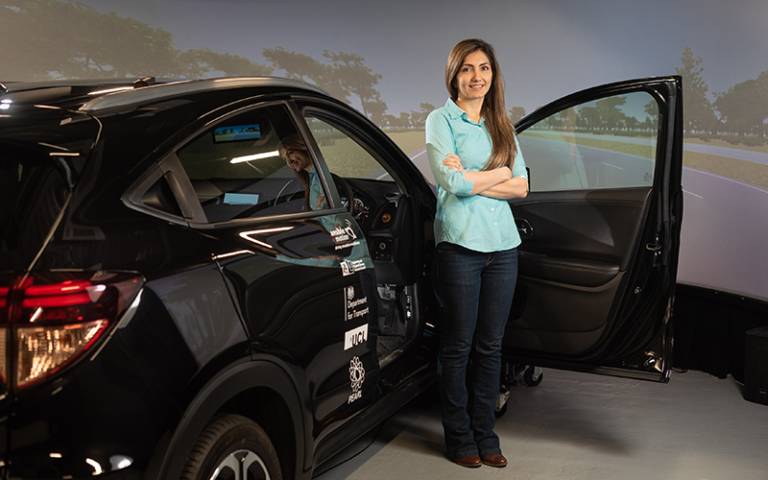Robotic driving seat helping to improve safety of highly automated vehicles
7 September 2023
A newly developed robotic driving seat will be showcased at the British Science Festival by UCL researchers, as part of ongoing efforts to increase public trust in highly automated vehicles.

The driving seat, developed by scientists from UCL’s Intelligent Mobility group (IM@UCL), signals to drivers in highly automated vehicles that human input is required and the vehicle operator needs to take back control. Its development is part of a project exploring communication between automated vehicles and human drivers.
Supported by the Engineering and Physical Sciences Research Council and Ansible Motion, the IM@UCL group developed a driving simulator setup that is capable of understanding the situational awareness of human drivers. Situational awareness is the ability to perceive, understand, and effectively respond to one's situation.
The setup captures the driver’s eye movements and measures their brain activity, which tells the onboard computer whether the driver has high or low situational awareness. This informs the car if the driver can safely take back control of the vehicle.
Highly automated and autonomous vehicles, which are not fully self-driving but are capable of taking over control from the driver in certain situations, are increasingly in use on the road. These autonomous systems are likely to be used in public transport of the future, making it important to gain public confidence in the safety of these vehicles.
When driving, humans make about 150 decisions per mile, including changing speed, switching lanes or changing direction. Research has shown that a significant number of safety-related incidents involving highly automated and autonomous vehicles occur during transfer of control from vehicle to human. Some incidents can be prevented if the vehicle is able to determine whether the driver has sufficient situational awareness to safely take control of the vehicle when it is not able to navigate autonomously.
Highly automated and autonomous vehicles currently available on the market provide audio and visual signals to drivers to alert them to take back control. But visual signals rely on the driver monitoring the dashboard and audio signals could be missed or would not be suitable for drivers with hearing difficulties. To address these issues, researchers at IM@UCL developed a way to alert drivers using physical feedback through a robotic driving seat as an additional safety measure.
Robotic structures embedded inside the seat can be pressurised by air, allowing the seat to communicate with the driver through touch. The seat can give a gentle ‘nudge’ if the vehicle determines that the driver lacks awareness of their surroundings, based on their eye movement and brain activity. The nudge informs the human driver to increase their situational awareness.
Professor Bani Anvari (UCL Civil, Environmental & Geomatic Engineering), Director of IM@UCL, said: "My vision is to enable humans to trust and fully exploit the benefits of highly automated and autonomous vehicles in the future through new technology. For example, through the detection of situational awareness in combination with the robotic driving seat. Autonomous vehicles are likely to be one of the first robots that many people engage with on a daily basis. In order for the public to fully trust this technology, we need to make sure that there is effective communication between the car and human.
"I’m looking forward to seeing how this technology advances and I’m also excited to showcase this for the public during the British Science Festival. Academia, industry and policymakers have to work together to gain the trust of road users, and I am pleased that my work can contribute to this."
Links
- Professor Bani Anvari's academic profile
- The British Science Festival
- Person Environment Activity Research Laboratory (PEARL)
- UCL Civil, Environmental and Geomatic Engineering
- UCL Faculty of Engineering
Image
Professor Bani Anvari with an automated vehicle. Credit: James Tye.
Media contact
Dr Matt Midgley
E: m.midgley [at] ucl.ac.uk
 Close
Close

